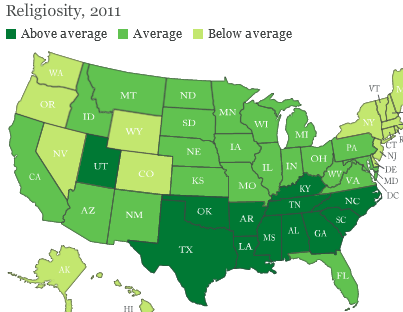Well, speak of the devil. Just as I wrote about the silly Huffington Post article earlier today that misrepresented New Atheist attitude about religiosity and poverty, I saw some data showcasing what New Atheists actually think about religiosity and poverty.
The data are deeply disturbing, but they are also enlightening.
If you suddenly lost your income, how long would you be able to live on your savings? For 43.9 percent of American households, the answer is less than three months, even if they keep their spending to the most basic needs. That’s not just true of families that know they’re close to poverty, either—one in four households earning between $55,465 and $90,000 are in the same boat, according to the 2013 Assets & Opportunities Scorecard.
Not even the middle class are immune from becoming homeless as a result of a crisis.
The scorecard, mapped out above, rates the states on how well they promote household financial security through jobs, education, health care, housing and financial assets. That means it looks not just at outcomes like how many people are three months from poverty or have health insurance, but what the states do on a policy level to make things better, like providing quality public education, having a minimum wage above the federal minimum of $7.25, prohibiting predatory payday lenders, supporting microenterprise, offering tax credits for working families. You know, things that are actually correlated with better outcomes for working people.
But what is impressive about the above map is how neatly it matches this map:
Clearly, the relationship is not perfect (for example, Utah is a very religious state, but its residents are not doing terribly poorly). Still, states where are a higher number of residents are at risk of falling into poverty are, overall, more likely to be highly religious.
And there is another angle to the story:
Unsurprisingly, as bad as that overall figure of 43.9 percent of families not having enough liquid assets to get through three months is, the numbers are far worse for people of color (the scorecard categories are not broken down beyond that): 62.6 percent are liquid asset poor, and white households have a median net worth of $110,973, 10 times that of households of color at $10,824.
We have discussed the effects of racial inequality on higher religiosity among minorities as well.
Which gives us the opportunity to examine what New Atheists think about poverty and religiosity. In the words of Professor Jerry Coyne,
In the end, I think more studies like this will ultimately explain much of the variation of religious belief among the world’s nations. And it tells us something important as activist atheists or secularists. We can’t get rid of religion simply by pointing out that it’s false, disenfranchises women, fosters guilt, and so on. Yes, those are important things to do, and do make converts, but in the end religion will be with us until we create more just, more egalitarian, and more caring societies.


